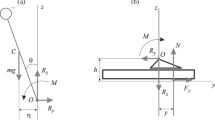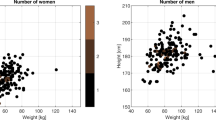Summary
A description is given of the vertical and horizontal components of the forces applied to the floor by the foot in walking.
Information about the characteristics of the normal force pattern was obtained from the analysis of the gait of 214 normal subjects (108 young adults, 63 elderly people and 43 children).
It is suggested that the normal gait pattern is characterised by a marked population variability, a considerable step-to-step consistency and symmetry of the forces from both feet. The force pattern in pathological gait secondary to disorders of the foot also shows a marked repeatability but is characterised by a pronounced asymmetry.
A specific disorder of the foot does not necessarily result in a typical corresponding force pattern. The measured data allow a functional diagnosis and show how the patient is reacting to his disability.
A force visualisation system is proposed permitting the immediate comparison between the normal and the affected foot and allowing long term assessment of subsequent changes. The force plates used also allow the recording of the progression of the centre of pressure in the foot and the measurement of the torque around the ankle joint.
Résumé
Cet article décrit les forces appliquées au sol dans la marche normale et dans la marche pathologique conséquence de lésions du pied.
Les caractéristiques de la courbe dynamographique normale ont été déterminées par les résultats d'une analyse de la marche de 214 sujets normaux (108 adultes jeunes, 63 sujets du 3ème âge et 43 enfants)
La marche normale est symétrique et très reproductible en dépit d'une grande variabilité individuelle. La courbe dynamographique de la marche dans des affections du pied montre également une reproductibilité marquée, mais elle est caractérisée par une asymétrie, variable selon les cas.
L'examen dynamographique ne donne qu'un diagnostic fonctionnel, on ne peut pas attendre un diagnostic médical immédiat des données fournies par les plateaux de force.
L'article propose un système de présentation, permettant la comparaison des forces verticales et antéro-postérieures du pied normal et du pied malade.
Avec les données fournies par les plateaux de force électroniques on peut établir la progression du centre de pression dans le pied et mesurer les moments de force au niveau de l'articulation tibio-tarsienne.
Similar content being viewed by others
References
Charnley J., Pusso R.: The recording and the analysis of gait in relation to the surgery of the hip joint. Clin. Orthop. 58 153–164 (1968)
Claeys R.: Foot-to-ground forces measurement in gait analysis (in press)
Debrunner H., Aebersold P., Stüssi E.: Ganganalyse. Pauwels Symposium. Biomechanik in Orthopädie und Traumatologie. pp. 259–274. Berlin (1979)
Hannah R.: Interpretation of clinical gait analysis data. Human Locomotion I. pp. 80–81. London, Ontario (1980)
Hennig E., Cavanagh P., Macmillan N.: High resolution in-shoe pressure distribution measurements by piezoelectric transducers. Human locomotion I. pp. 120–121. London, Ontario (1980)
Leduc A., Reyns I., Demaree G., Wellens L.: Fotoelastopometrie, a technique for investigation of the force distribution under the foot during gait. Chir. del Piede. 4 295–302 (1980)
Suzuki R.: Analysis of normal and pathological walking by force plate and electromyogram. Biomechanics V-A pp. 341–346. Baltimore: Univ. Park Press 1976
Simon S., Mann R., Hagy J., Larsen L.: Role of the posterior calf muscles in normal gait. J. Bone Joint Surg. 60 A 465–472 (1978)
Stallard J., Tait J., Rose G.: Video vector display of ground reaction forces during physical activity. Human Locomotion I. pp. 102–103. London, Ontario (1980)
Stokes A., Stott J., Hutton W.: Force distributions under the foot, a dynamic measuring system. Biom. Eng. 9 140–143 (1974)
Author information
Authors and Affiliations
Rights and permissions
About this article
Cite this article
Claeys, R. The analysis of ground reaction forces in pathological gait secondary to disorders of the foot. International Orthopaedics 7, 113–119 (1983). https://doi.org/10.1007/BF00266460
Issue Date:
DOI: https://doi.org/10.1007/BF00266460




